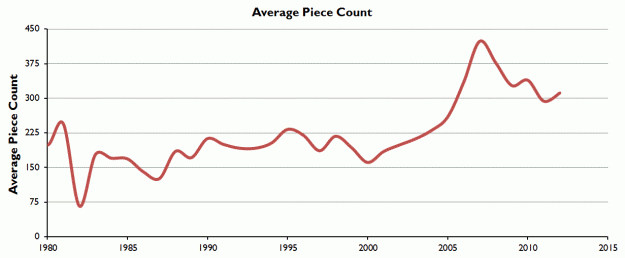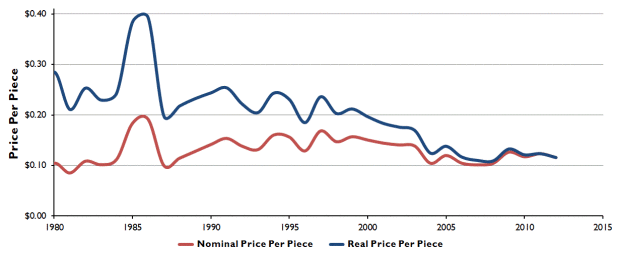Reality Prose has an excellent analysis on the changing price of LEGO bricks over the years and a misconception that cost has gone up. According to the chart above, based on data from BrickSet and adjusted for inflation, the average cost per brick has come down.
So why the perception of high LEGO prices? It might have something to with average piece count and more complex sets.
With the data from the piece price evaluations I was able to also evaluate the average size of LEGO sets each year. As you can see on the chart below, the average size of sets released each year stayed somewhat constant from 1980-1990 until around 2000 which set sizes started to increase. The average set size seems to have peaked in 2008 (which saw the release of the Taj Mahal), but since then it hasn’t fallen to its pre-2000 levels. It seems to have found a new normal around 300 pieces.

But even so, LEGO hasn’t stopped making the lower-priced sets. It’s just that’s there’s a wider variety now. Be sure to read the complete analysis. It’s a fun one.
Side note: We had some friends over the other day, and someone brought a giant castle LEGO set. I don’t know how much it cost, but the hours of entertainment we got for a group of six people? Priceless. [via @hmason]



Not doing this with LEGO brick bar charts is obviously a chance missed.
Someone make a youtube video of a lego stop-motion Hans Rosling narating this in front of a giant animated lego brick bar chart visualisation.
Bonus points if each change in the lego brick visualisation is done by a team of stop-motion lego monkeys. They were the best. :)
Surely this is one of those mean/median things? If the mean price stays the same or comes down because of a growing number of huge sets with abnormally low prices per brick, that doesn’t mean it’s not possible the median prices of more typical smaller sets are going up.
It’s also a question of timing. I bought Lego sets for myself during the 70s and early 80s. Now I buy them for my own kids. The prices now are higher than they were when I was in a kid. (Although the 70s aren’t in the chart.) The fact that prices went up when I wasn’t buying them does not affect my perception of rising prices.
Further to Al’s point, above…as the lucky father of two Lego loving sons, I’m kinda living this data. There are two trends that need to be addressed here: 1. The growth of mega sized, 1000 piece sets. These are probably both inflating the perception of high prices AND driving down the average price 2. The growth of ‘themed’ sets, where I suspect the price per piece goes up because of the premium on the storyline, cachet and collectibility of the set. Those two products should be broken out from the aggregate. Would be interesting to see!
I would like to say that the prices have skyrocketed in all actuality. My son loves legos and we both build stuff together. I can tell you that many of the large box sets use a ton of tiny pieces when they are not needed. This is to get the number of bricks up. You will always see a lot of those little 1 piece squares that are thin or may have a smooth top. I’m not necessarily bashing LEGO, because one thing that has raised the cost is licensing. Star Wars, Marvel, LOTR, DC, always cost a little more. I don’t know their exact licensing agreements, but I would be willing to bet that they are having to pay for licensing for these sets.